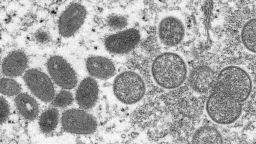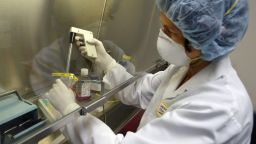A monkeypox outbreak continues to grow in countries where the virus isn’t normally found, putting global health officials on high alert.
Now with more than 643 cases of monkeypox in dozens of countries where the virus is not endemic, “the sudden appearance of monkeypox in many countries at the same time suggests there may have been undetected transmission for some time,” World Health Organization Director-General Tedros Adhanom Ghebreyesus said Wednesday.
The virus has been circulating for decades in some places, including parts of West and Central Africa. In early research posted this week, scientists at the Institute of Evolutionary Biology at the University of Edinburgh described how the genetic pattern they’re seeing suggests that “there has been sustained human to human transmission since at least 2017.”
In that research, genetic sequences showed that the first monkeypox cases in 2022 appear to have descended from an outbreak that resulted in cases in Singapore, Israel, Nigeria and the United Kingdom from 2017 to 2019.
Michael Worobey, an evolutionary biologist and professor at the University of Arizona who was not involved in the research, said it suggests that “this outbreak has been going on for a long time, locally,” as in where the virus is endemic. And it means the world has failed to protect those in resource-limited areas where it has been endemic and to control it at its source before it spread globally, he added.
“It’s really a tale of two outbreaks,” Worobey said. “We need to actually turn our attention to where it’s been spreading … and start caring about that population just as much as we care about what’s going on in all these other countries around the world.”
If research continues to show that the virus has spread more among humans than previously thought – more distant from an animal source, that is – Worobey said one “really good question” is, why wouldn’t the world think monkeypox can be endemic in places beyond West and Central Africa?
‘We don’t even know how long this has been spreading’
Epidemiologist Anne Rimoin has been studying monkeypox for about two decades and has long warned that its spread in places like the Democratic Republic of the Congo could have broader global health implications.
“If monkeypox were to become established in a wildlife reservoir outside Africa, the public health setback would be difficult to reverse,” Rimoin, now a professor of epidemiology at the UCLA Fielding School of Public Health, warned in a 2010 article published in the Proceedings of the National Academy of Sciences.
The latest monkeypox outbreak is proving difficult to predict in part because we haven’t been able to fully trace its origins.
“We don’t even know how long this has been spreading,” Rimoin said. “This could have been spreading silently for a while.
“It’s like we’ve now decided to watch a new series, but we don’t know exactly which episode we’ve landed on. I mean, are we on episode two, or are we onepisode four, or are we on episode 10? And how many episodes are in this series? We don’t know.”
Previous human cases of monkeypox weren’t thought to be too far removed from some initial exposure to an infected animal – typically rodents. Once the virus is circulating among these animals, it can continue jumping back into humans who might come into contact with infected squirrels or guinea pigs, for example.
If we continue to see sustained person-to-person transmission in this outbreak, even at low levels, that brings the possibility of a spillover back intoanimals in nonendemic countries from “an existential threat to a distinct possibility,” Rimoin told CNN. Such a spillover could then allow the virus to remain in an environment, jumping between animals and humans over time.
“Canon has been, monkeypox will burn itself out” after a short chain of human transmission, Rimoin said. However, although our knowledge of the virus goes back decades, it’s now spreading among new places and populations. For epidemiologists, that means keeping an open mind.
“We know a fair amount about this virus, but we don’t know everything about this virus,” she said. “We’re going to have to study this very carefully.”
Too early to tell
WHO officials say the global public health risk is moderate.
“The public health risk could become high if this virus exploits the opportunity to establish itself as a human pathogen and spreads to groups at higher risk of severe disease such as young children and immunosuppressed persons,” according to a WHO risk assessment issued Sunday, which added that “immediate action from countries is required to control further spread among groups at risk, prevent spread to the general population and avert the establishment of monkeypox as a clinical condition and public health problem in currently non-endemic countries.”
In a news briefing last week, an official with the US Centers for Disease Control and Prevention said that it’s “too early to tell” whether the virus could become endemic in the United States but that experts remain “hopeful” that won’t happen.
“I think we’re in the very early days of our investigations,” said Dr. Jennifer McQuiston, deputy director of the CDC’s Division of High Consequence Pathogens and Pathology.
McQuiston pointed out that the virus didn’t become endemic after the last monkeypox outbreak in the United States, in 2003, when pet prairie dogs led to dozens of infected people across multiple states.
“We’re hopeful we’ll be able to similarly contain this,” McQuiston said.
The European CDC appeared to agree with McQuiston in its own assessment last week, saying there’s no evidence that the virus established itself in US wildlife after authorities conducted “an aggressive campaign for exposed animals during the 2003 outbreak.”
According to the European agency, “The probability of this spill-over event is very low.”
Still, it wouldn’t be the first virus to take up residence in a US animal population, said Dr. Amesh Adalja, senior scholar at the Johns Hopkins Center for Health Security at the Bloomberg School of Public Health. Before 1999, West Nile virus was unheard-of in the US. Now, it’s the leading cause of mosquito-borne disease in the country.
“It got seeded into mosquito populations and … bird populations and was able to establish itself,” Adalja said.
Still, he agrees that this is far from an inevitability with monkeypox because “2003 was a good opportunity for it to happen” – and it didn’t.
Worobey says there are too many unknowns to figure out where this monkeypox outbreak is headed.
“What we’re finding out here, in real time, is that we know very little about what’s going on,” he said, “and I think it’s too early to be giving blanket reassurances.”
A different landscape
It’s not just murky beginnings and silent spread that make this monkeypox outbreak hard to predict.
“It’s just a very different epidemiological landscape,” Rimoin added.
“What we know about monkeypox comes largely from studies in very remote rural communities in Central Africa, where the transmission dynamics are bound to be very different,” she said, especially compared with “high-resource settings in Europe or the US.”
And although a full-fledged pandemic isn’t yet a concern, that doesn’t mean certain groups aren’t at risk, a WHO official said Monday.
“At the moment, we are not concerned of a global pandemic,” said Rosamund Lewis, technical lead for monkeypox at the WHO Health Emergencies Programme.
However, “we are concerned that individuals may acquire this infection through high-risk exposure if they don’t have the information they need to protect themselves,” she said. “And we are concerned that, because the global population is not immune to orthopoxviruses since the end of smallpox eradication, that the virus may attempt to exploit a niche and spread more easily between people.”
Health authorities have warned that, although anyone can get the virus, members of the LGBTQ community appear to have a higher risk of exposure at the moment.
“What we’re seeing now began as a small cluster of cases, and then the investigation rapidly led to discovery of infections in a group of men who have sex with men … and so we don’t yet know what the source of the actual outbreak is,” Lewis said Tuesday.
“What’s most important now is not to stigmatize,” she said.
A number of other lingering questions could also change our understanding of how well the virus spreads from person to person. For example, it’s unclear how much spread there is when people have minimal symptoms or what effect mutations may have on the virus.
On those points, Adalja said, there’s no reason to be concerned yet.
For one, the fact that doctors are seeing a number of cases with lesions in the groin area – versus more common areas such as the face, hands and feet – suggests to him that close contact with symptomatic people with skin lesions is more likely driving the spread, Adalja said.
And although it’s important to run down any viral mutations we see with monkeypox, this virus mutates relatively slowly because its genome is made of double-stranded DNA, which is more stable than, say, the single-stranded RNA of coronaviruses.
The pace of those mutations seems to have sped up somewhat, Worobey said of the early Edinburgh research. However, the global outbreak probably has far more to do with the virus gaining access to new circles where it’s easy to transmit and not “the relatively small number of mutations that have accumulated since 2017,” he added.
When it comes to whether the virus is currently changing in significant ways, “we don’t have the answer to this. We don’t really know,” Lewis said last week.
Get CNN Health's weekly newsletter
Sign up here to get The Results Are In with Dr. Sanjay Gupta every Tuesday from the CNN Health team.
“We don’t yet have evidence that there’s mutation in the virus itself. We are beginning to collect that information,” she said. “We will be convening our groups of virologists and other experts who will discuss this very question based on the sequence of the genome of some of the cases that are being detected.”
Meanwhile, health officials around the world continue to track cases and the contacts of those cases to better understand how the virus is spreading – and how to stop it.
“Right now,” Rimoin said, “we have to do everything we can to stop community transmission.”
CNN’s Arnaud Siad and Emmet Lyons contributed to this report.







